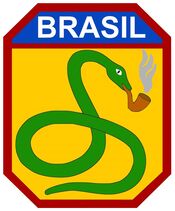 "It's more likely for a snake to smoke a pipe than for the FEB to go to the front and fight". -- Basically a Brazilian version of "When pigs fly". On this day in history, 21 February 1945, the Forca Expedicionaria Brasileira (Brazilian Expeditionary Force) conclusively put that saying to rest when they, alongside American forces (including the 10th Mountain Division), defeated dug-in German defenders at the Battle of Monte Castello in Italy. Click below to read more! In August of 1942 Brazil, after a period of heightened tensions and escalating U-boat attacks, declared war on Germany and Italy. In consultation with America it was decided to create the Brazilian Expeditionary Force (BEF) and send them to fight in the European theater of operations. This proved easier said than done, and it took over two years between the declaration of war and the actual deployment of Brazilian combat troops into the ETO. This led many Brazilians to say that only "when snakes smoke" will the BEF go to war. But by mid-1944 they were ready, and proudly wearing their patch of a smoking snake and calling themselves "Cobras Fumantes" or Smoking Snakes (a pretty classy flex on their haters if I do say so myself). While there were a number of logistical hurdles to still overcome, they eventually entered battle in late November 1944 at Monte Castello. While it took a total of 89 days to eventually wrest the heights from the German defenders, the men of the BEF acquitted themselves well as a brave and effective fighting force. Their actions also changed the meaning of the phrase in Brazilian society -- now when someone says "a cobra vai fumar" or "the snake will smoke" it means that something will definitely happen. Armed with Simplified Logistics
The BEF initially deployed without weapons, and were only equipped after landing in Italy. They received primarily US equipment to include rifles, helmets, and uniforms, and at first glance a casual observer of a photograph might easily mistake them for US troops. One type of rifle they carried was the m1903A3. Building a Simpler m1903 The m1903A3 was a simplified version of the earlier m1903, designed to be easier and cheaper to produce. Towards that end it made extensive use of stamping to replace many formerly milled parts (barrel bands, sling swivels, rear sight, magazine / trigger guard). The most notable change is the rear sight, situated high atop the receiver bridge near the rear of the receiver. This not only removed the need to mill the relatively complicated rear ladder sight of the m1903, but it also provided an easy to use aperture sight that a modern shooter is sure to love. Archival Research Group has an excellent set of documents detailing how the Army figured out how best to mount this new-fangled sighting system. What is really impressive is how fast it went from "experimental" at Fort Benning to standardized in production. Chambered for the potent 30-06 cartridge this rifle was perfectly suitable for use during WW2. Although it wasn't as throughly modern as the standard issue semi-automatic M1 "Garand", it more than held its own against the bolt action Mausers of the German defenders. This particular rifle was manufactured by the Smith-Corona Typewriter Company in 1943. Similar rifles were also produced by the Remington Arms Company (who also used this pattern rifle as the basis for the 1903A4 sniper rifle). It bears the inspector marks of FJA for Frank J. Atwood, as well as a somewhat sloppily stamped ordnance wheel mark. These rifles are an interesting blend of the old and the new. While the basic design of the weapon was over 40 years old by the time it found its way into the hands of the BEF (and still maintained archaic features like a magazine cut-off in the era of semi-automatics), the demands of war meant that his updated version of the venerable Model 1903 would continue to soldier on for the duration.
0 Comments
Leave a Reply. |
Jon K.Weapons collector, history buff, Army officer, Pug enthusiast. Archives
December 2020
Categories
All
|
 RSS Feed
RSS Feed
